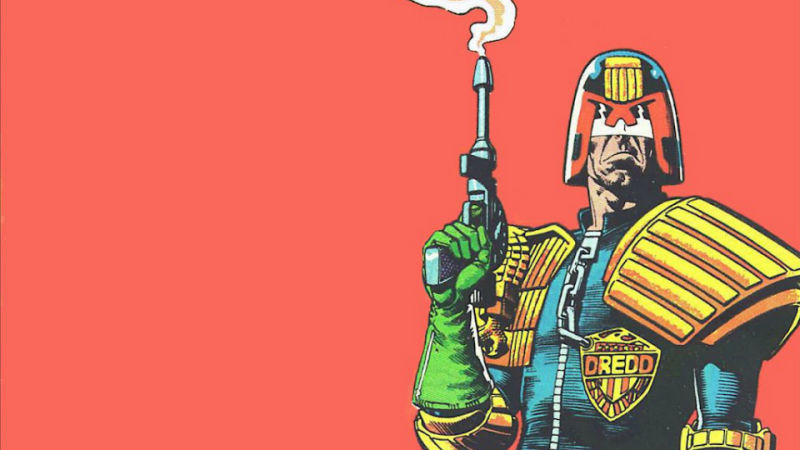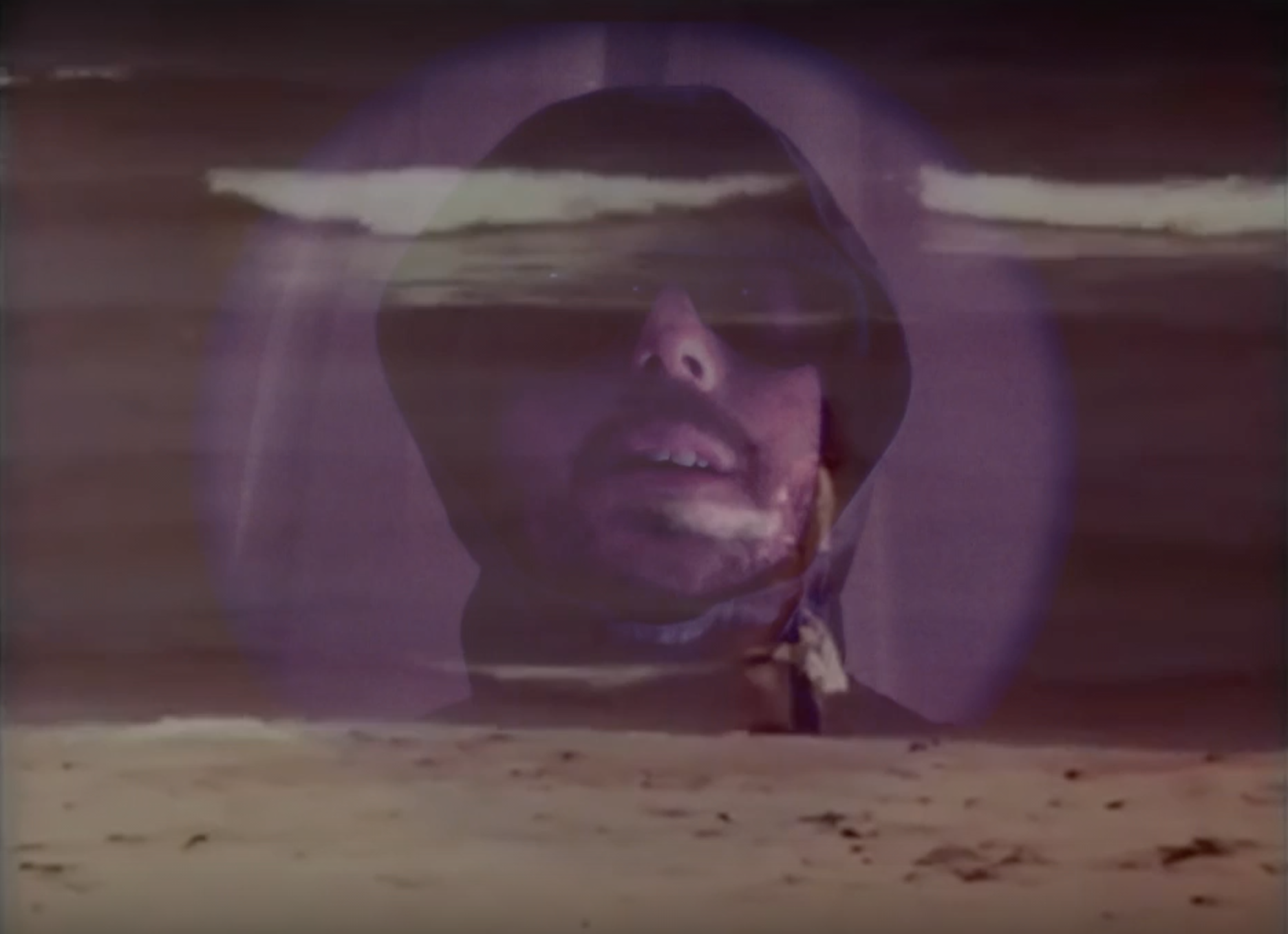The war to end all wars. Senseless carnage on a scale unimagined. The East-Coast of what used to be the United States lies in ruins, occupied by foreign invaders.
In the wastelands of the former Soviet Russia, a group of elite operatives infiltrate a nuclear bunker. Aiming the missiles at their enemies’ capital, a captive pleads for mercy.
“Judge Dredd – don’t do it! There are half a billion people in my city – half a billion human beings! You can’t just wipe them out with the push of a button!”
Dredd stares at the control panel, battered, bruised, but with grim purpose.
“Can’t I? Half my city is burnt to ash by East-Meg missiles – and you’re begging me for mercy?”
He pushes his finger down upon the launch control.
“Request denied!”
In 1982, the Cold War was still very much in effect, tensions between East and West forever threatening to boil over into outright hostility. But this time, it wouldn’t be a conventional war, fought with men, and tanks, and planes. This time, war would be fought with missiles, and the policy of Mutually Assured Destruction. When the launch codes are accepted, there wouldn’t likely be anyone left to question the morals behind such a decision.
And in the pages of long-running British Weekly comic 2000AD, futuristic lawman JudgeDredd was taking the sabre rattling of the Cold War to its logical conclusion.
Created by writer John Wagner, and artist Carlos Ezquerra, Dredd first appeared in the second issue of the comic in 1977. A tough, no-nonsense cop, he patrolled the streets of Mega-City 1, a sprawling metropolis that covers the eastern seaboard of America. Dredd was one of the Judges, an elite police force gifted with the power of judge, jury, and executioner. Confronted with all manner of bizarre and outlandish crimes, Dredd cruised through the comic, dispensing justice, usually at the end of the barrel of his Lawgiver handgun.
Early strips found the Judge facing off against criminals who could change their face, people who sold contraband like sugar and old comics (!), in a city where fads could spread like wildfire, mania could set in at any point, and every citizen was nothing more than a potential lawbreaker. On more than one occasion, he’s prevented people from committing suicide by jumping from high buildings, not out of any humanitarian concern, but because littering is an offence. A jet-black humour quickly crept in, with Wagner and other writers like Pat Mills using the strip to satirise contemporary Britain. Dredd may well have been an American, but the tone of the strip was quintessentially British, a deeply anti-authoritarian sense of anarchy, where the good guy was someone who’d point a gun at you for dropping litter on the street.
Unlike the majority of US comics, Judge Dredd was a satirical anti-hero, the faceless symbol of a system that wanted to crush you in pursuit of your own protection. The Justice System was absolute, a totalitarian nightmare which perpetuated fear, rather than a sense of safety. The city’s ‘Iso-Blocks’ became increasingly crowded, whilst it was apparent that every single citizen of Mega-City 1 was a prisoner in their own way.
As the years went by, the world was expanded, painting a vivid picture of the world in the 22nd century. America largely consisted of three cities, Mega-City 1 & 2, with Texas City existing as the perpetual outsider. In between the huge urban sprawls lay the Cursed Earth, an atomic wasteland populated by the ruins of a pre-war America. Across the ocean, the toxic Black Atlantic, lay Brit-Cit, a mish-mash of old world values and 22nd century paranoia. And to the east, was the Great Enemy – the Sovs.
East-Meg 1 and East-Meg 2 was the Cold War gone into overdrive. Shadowy figures, hell-bent on war, the Sovs established themselves as a lingering presence in the backdrop to Dredd’s adventures, tangled plots forming webs at the edge of his consciousness.
By 1982, Wagner felt the strip was becoming unmanageable. Mega-City 1, with its population of 800 million citizens, was too unwieldy a beast to be controlled. To streamline things, John Wagner essentially brought the Cold War to its conclusion, allowing the Sovs to annihilate the city in spectacular fashion. Over 25 weekly episodes, in the Apocalypse War, nuclear missiles rained down upon Mega-City 1, a ground invasion pulverised hapless citizens into submission, tidal waves washed away whole sections of the city, and the full effects of a nuclear winter swept away all resistance.
Except the Judges.
Fighting an embittered ground war, Dredd and the rest of the Judges used guerrilla tactics, hit and run assaults, sabotage, and executions to fight their enemies, and corral their own population into obedience. In the end, leading a sneak attack against the Sovs, he used their own missiles to wipe their face off the earth. With chilling purpose, Dredd sees the situation in black and white – it was us or them – and dooms millions of innocent people to death.
And – yet again – he was the good guy. Aside from the rollicking action, The Apocalypse War was jet black satire, looking at the idiocy of the two real-life power blocks staring each other down whilst gripping a nuclear inferno in their hands. Government at the highest level is largely unconcerned with the will or safety of the people, and neither side seems too sure – or interested – in why the war has started; all that’s important is winning, the prize being a load of charred, radioactive ruins. And in the midst of it all, the citizens exhibit all of their usual madness, with a new dance craze spreading like wildfire (‘The Apocalypso’), and Dredd’s Italian cleaning lady and his house robot Walter leading a two-man war of their own, armed only with a cooking knife.
The Apocalypse War captures Dredd at his finest, with Wagner and Ezquerra at the height of their powers. In 2000AD, essentially a children’s comic, they created an anti-nuclear, anti-fascist work of protest that is as potent – and as funny – today as it was then.
By this point, outside of comics, Dredd had become an icon – a symbol of brutal justice, resonating with the Thatcher government. As cops in riot gear charged at protestors, it was easy to imagine Dredd at the forefront, swinging his daystick. In the eyes of many, the faceless Judge (he never removed his helmet, establishing himself as the faceless nature of justice), represented the end result of the police state that Thatcher seemed to be pushing towards, her apparent desire for control mirroring the Judges’ dominance of all aspects of society, and her war with the Falklands echoing the senseless carnage of the Apocalypse War. When people needed a symbol of tyranny, look no further than the Judge.
This political aspect really began to assert itself in the mid to late 80s, where Dreddfaced off against an enemy more evil than any he had previously faced – democracy itself. Inspired by political upheaval and activism in the UK, Wagner continued to flex his satirical muscles, setting the Judges up against democratic process, with people taking to the streets to riot in the name of democracy. With readers writing to 2000AD to compliment the Judges’ hard-line stance on crime, Wagner and co-writer Alan Grant upped the ante, exposing the Justice system as a tyrannical, unelected dictatorship. And as they trampled over the rights of citizens to exercise their democratic rights, yet again, we were faced with a ‘hero’ whose very existence was to restrict and control your existence. As the man himself once said, “Justice has a price. The price is freedom.”
With unrest in Russia, the imminent collapse of the Berlin Wall, and the student protests in Tiananmen Square providing the backdrop in the real world, Dredd’s message was clear – better the devil you know, rather than the promise of something new.
Unusually for a comics character, Judge Joe Dredd has aged in real time. And while he’s never quite mellowed, the hardliner who landed his oversized green boot upon democratic protesters has matured. It’s no longer black and white for the Judge, there are shades of grey. And with the strip still wrestling with these philosophical questions of freedom and control, the older Dredd has compromised when the situation allowed it, and seems perpetually aware of his position as a pawn in a game of chess. And for potential lawbreakers who feel the Judge has gone soft, he’s still fond of giving people a daystick to the face for stepping out of line, and has never seemed to tire of giving excessive sentences for minor crimes.
John Wagner couldn’t have guessed that this futuristic cop would still be going strong 40 years later, but the world he created continues to be just as compelling, if not more so. The world is a strange place, and Dredd’s world will always be at least two degrees stranger. As we look to the White House and see President Donald J Trump, perhaps we can see echoes of President Robert L Booth, last president of the United States, a man who launched the nukes to make America great again, by destroying everything else. The real world will provide fodder for Dredd’s world, and his own rich history continues to expand and impact upon his future. That dreadful decision to fire the missiles at East-Meg 1 back in 1982 still has profound implications for Dredd and his world. And while the Judge can’t afford to make mistakes, Dredd has been haunted by his actions, doubt creeping in during his darkest moments.
And he’s older now. He’s not as limber, the chin is more grizzled, and a toll has been taken upon Mega-City 1’s top lawman. For readers, right from the very start back in 1977, we’ve always known Dredd will die on the streets. Sure, he’s been cloned, resigned, faked his own death, and everything else in between, but someday death will find him. And far from ending the strip, the idea of Dredd’s death only opens up further dramatic possibilities. Will the Judges survive without him? Is a symbol more than a man? As the ultimate hardliner, will the Judges soften?
Uniquely amongst comics characters, Dredd is almost a supporting character in his own story. He is a symbol, an image, and the real character comes from the world he inhabits, and his place in it. Despite his ‘cult’ status as a UK comics character, Dredd’s face is a universal symbol of authority, his name a by-word for legal tyranny, despite many of us knowing nothing more about him than his own oft-repeated claim, “I am the law.” Batman can brood, the Avengers can crack wise, but Dredd remains relevant, stern and solemn in the face of a planet that’s teetering out of control.
As Judge Dredd turns 40, we can look to our own world and maybe, if we squint a little, it’s starting to look a little more and more like Mega-City 1. And if that does become the case, and we’re plunged into unelected, right-wing tyranny, then we could do a lot worse than Judge Joe Dredd. He might not be pleasant, he might not smile, but when it comes to enforcing the law, as the great man himself has said, “I’m a stickler.”
Happy birthday, Joe. Steven Rainey





